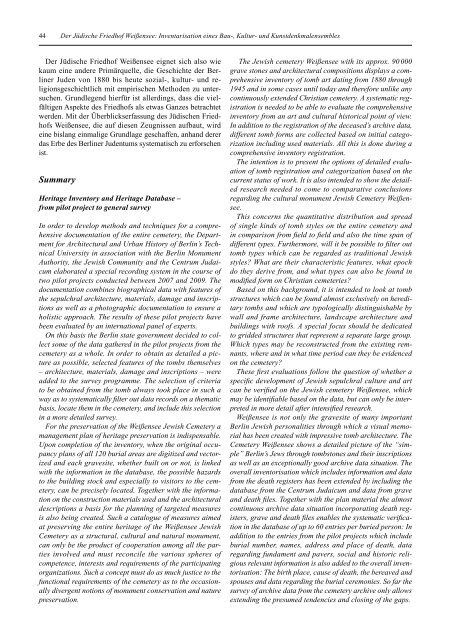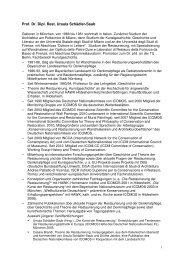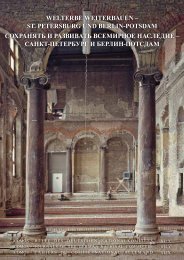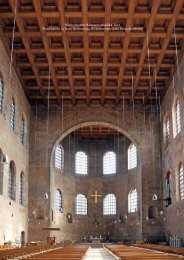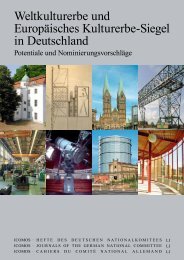Download der Publikation im PDF-Format - Icomos
Download der Publikation im PDF-Format - Icomos
Download der Publikation im PDF-Format - Icomos
Sie wollen auch ein ePaper? Erhöhen Sie die Reichweite Ihrer Titel.
YUMPU macht aus Druck-PDFs automatisch weboptimierte ePaper, die Google liebt.
44<br />
Der Jüdische Friedhof Weißensee: Inventarisation eines Bau-, Kultur- und Kunstdenkmalensembles<br />
Der Jüdische Friedhof Weißensee eignet sich also wie<br />
kaum eine an<strong>der</strong>e Pr<strong>im</strong>ärquelle, die Geschichte <strong>der</strong> Berliner<br />
Juden von 1880 bis heute sozial-, kultur- und religionsgeschichtlich<br />
mit empirischen Methoden zu untersuchen.<br />
Grundlegend hierfür ist allerdings, dass die vielfältigen<br />
Aspekte des Friedhofs als etwas Ganzes betrachtet<br />
werden. Mit <strong>der</strong> Überblickserfassung des Jüdischen Friedhofs<br />
Weißensee, die auf diesen Zeugnissen aufbaut, wird<br />
eine bislang einmalige Grundlage geschaffen, anhand <strong>der</strong>er<br />
das Erbe des Berliner Judentums systematisch zu erforschen<br />
ist.<br />
Summary<br />
Heritage Inventory and Heritage Database –<br />
from pilot project to general survey<br />
In or<strong>der</strong> to develop methods and techniques for a comprehensive<br />
documentation of the entire cemetery, the Department<br />
for Architectural and Urban History of Berlin’s Technical<br />
University in association with the Berlin Monument<br />
Authority, the Jewish Community and the Centrum Judaicum<br />
elaborated a special recording system in the course of<br />
two pilot projects conducted between 2007 and 2009. The<br />
documentation combines biographical data with features of<br />
the sepulchral architecture, materials, damage and inscriptions<br />
as well as a photographic documentation to ensure a<br />
holistic approach. The results of these pilot projects have<br />
been evaluated by an international panel of experts.<br />
On this basis the Berlin state government decided to collect<br />
some of the data gathered in the pilot projects from the<br />
cemetery as a whole. In or<strong>der</strong> to obtain as detailed a picture<br />
as possible, selected features of the tombs themselves<br />
– architecture, materials, damage and inscriptions – were<br />
added to the survey programme. The selection of criteria<br />
to be obtained from the tomb always took place in such a<br />
way as to systematically filter out data records on a thematic<br />
basis, locate them in the cemetery, and include this selection<br />
in a more detailed survey.<br />
For the preservation of the Weißensee Jewish Cemetery a<br />
management plan of heritage preservation is indispensable.<br />
Upon completion of the inventory, when the original occupancy<br />
plans of all 120 burial areas are digitized and vectorized<br />
and each gravesite, whether built on or not, is linked<br />
with the information in the database, the possible hazards<br />
to the building stock and especially to visitors to the cemetery,<br />
can be precisely located. Together with the information<br />
on the construction materials used and the architectural<br />
descriptions a basis for the planning of targeted measures<br />
is also being created. Such a catalogue of measures a<strong>im</strong>ed<br />
at preserving the entire heritage of the Weißensee Jewish<br />
Cemetery as a structural, cultural and natural monument,<br />
can only be the product of cooperation among all the parties<br />
involved and must reconcile the various spheres of<br />
competence, interests and requirements of the participating<br />
organizations. Such a concept must do as much justice to the<br />
functional requirements of the cemetery as to the occasionally<br />
divergent notions of monument conservation and nature<br />
preservation.<br />
The Jewish cemetery Weißensee with its approx. 90 000<br />
grave stones and architectural compositions displays a comprehensive<br />
inventory of tomb art dating from 1880 through<br />
1945 and in some cases until today and therefore unlike any<br />
continuously extended Christian cemetery. A systematic registration<br />
is needed to be able to evaluate the comprehensive<br />
inventory from an art and cultural historical point of view.<br />
In addition to the registration of the deceased’s archive data,<br />
different tomb forms are collected based on initial categorization<br />
including used materials. All this is done during a<br />
comprehensive inventory registration.<br />
The intention is to present the options of detailed evaluation<br />
of tomb registration and categorization based on the<br />
current status of work. It is also intended to show the detailed<br />
research needed to come to comparative conclusions<br />
regarding the cultural monument Jewish Cemetery Weißensee.<br />
This concerns the quantitative distribution and spread<br />
of single kinds of tomb styles on the entire cemetery and<br />
in comparison from field to field and also the t<strong>im</strong>e span of<br />
different types. Furthermore, will it be possible to filter out<br />
tomb types which can be regarded as traditional Jewish<br />
styles? What are their characteristic features, what epoch<br />
do they <strong>der</strong>ive from, and what types can also be found in<br />
modified form on Christian cemeteries?<br />
Based on this background, it is intended to look at tomb<br />
structures which can be found almost exclusively on hereditary<br />
tombs and which are typologically distinguishable by<br />
wall and frame architecture, landscape architecture and<br />
buildings with roofs. A special focus should be dedicated<br />
to gridded structures that represent a separate large group.<br />
Which types may be reconstructed from the existing remnants,<br />
where and in what t<strong>im</strong>e period can they be evidenced<br />
on the cemetery?<br />
These first evaluations follow the question of whether a<br />
specific development of Jewish sepulchral culture and art<br />
can be verified on the Jewish cemetery Weißensee, which<br />
may be identifiable based on the data, but can only be interpreted<br />
in more detail after intensified research.<br />
Weißensee is not only the gravesite of many <strong>im</strong>portant<br />
Berlin Jewish personalities through which a visual memorial<br />
has been created with <strong>im</strong>pressive tomb architecture. The<br />
Cemetery Weißensee shows a detailed picture of the “s<strong>im</strong>ple”<br />
Berlin’s Jews through tombstones and their inscriptions<br />
as well as an exceptionally good archive data situation. The<br />
overall inventorisation which includes information and data<br />
from the death registers has been extended by including the<br />
database from the Centrum Judaicum and data from grave<br />
and death files. Together with the plan material the almost<br />
continuous archive data situation incorporating death registers,<br />
grave and death files enables the systematic verification<br />
in the database of up to 60 entries per buried person: In<br />
addition to the entries from the pilot projects which include<br />
burial number, names, address and place of death, data<br />
regarding fundament and pavers, social and historic religious<br />
relevant information is also added to the overall inventorisation:<br />
The birth place, cause of death, the bereaved and<br />
spouses and data regarding the burial ceremonies. So far the<br />
survey of archive data from the cemetery archive only allows<br />
extending the presumed tendencies and closing of the gaps.


